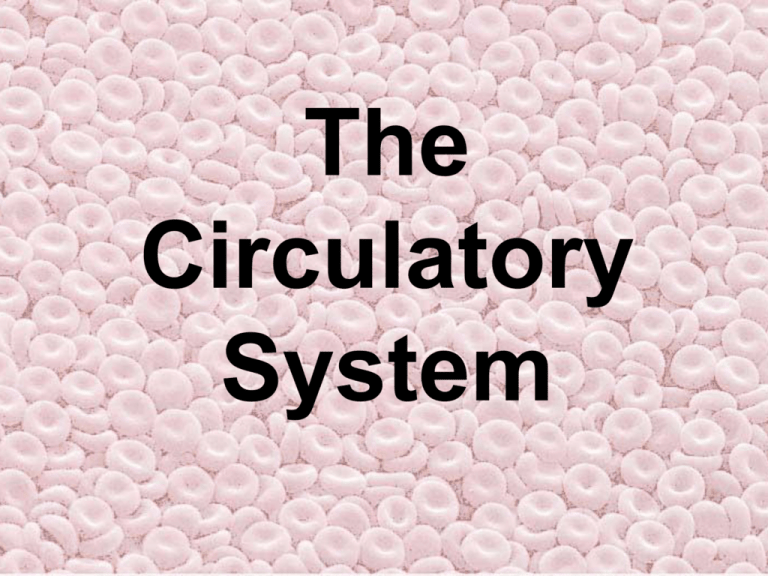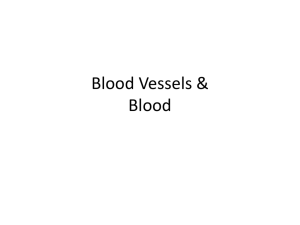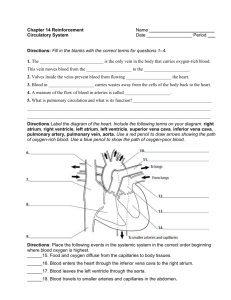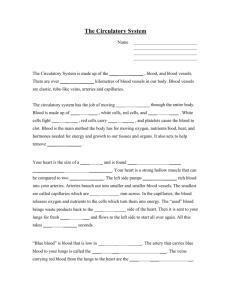The Circulatory System
advertisement

The Circulatory System Which activity caused the pulse rate to increase the most? The activity that was the most rigorous. What is the relationship between physical activity and pulse rate? Increased physical activity causes and increased pulse rate. Why do you think activity caused the heart to pump faster? The muscles need more oxygen and need to get rid of waste faster. The heart pumps faster to get more blood to the muscles. The Circulatory System • Made up of (organs): – heart – blood vessels (veins and arteries) – blood – smooth muscle – cardiac muscle Main Functions • Moves needed materials around the body – glucose – oxygen – water – lipids • Carries waste away from the cells – carbon dioxide – lactic acid – urea • Contains disease fighters The Heart • Hollow, muscular organ that pumps blood throughout the body – size of your fist – located in the center of the chest Structure of the Heart • The heart has two sides • Each side has an upper chamber – Atrium • Each side has a lower chamber – Ventricle Structure of the Heart • Blood enters the heart through the atria – From the body – right atrium – From the lungs – left atrium • Blood leaves the heart through the ventricles – To the body – left ventricle – To the lungs – right ventricle How the Heart Works How the Heart Works • The heart’s action has two phases – The heart relaxes and the atria fill with blood – The atria contract, blood is pumped into the ventricles, then the ventricles contract and send blood out of the heart • Blood only travels in one direction, it cannot flow backwards Regulation of the Heartbeat • The heart contains pacemaker cells that tell the heart when to beat – When you are exercising, excited, scared etc…, your heart beats faster – When you are relaxed, calm, asleep etc…, your heart beats slower Blood Vessels • Blood vessels transport blood around your body • They run through all the tissue in your body • Some are as wide as your thumb • Some are as small as a hair Arteries • Carries oxygen rich blood away from the heart • The ventricles of the heart pump into the arteries to get blood to the rest of your body • As arteries get further from the heart, they branch and get smaller and turn into arterioles • Artery walls are very thick, strong and flexible • They contain smooth muscle that contracts or relaxes to let more or less blood through Arteries Regulating Blood Flow • The muscles in the middle layer are involuntary smooth muscles • When they contract, the artery becomes smaller • When they relax, the artery becomes larger Regulating Blood Flow • When an organ needs more blood, the arteries relax to let more flow in • Food in your stomach triggers your arteries going to the stomach to relax so more blood is sent there • During exercise, the arteries to your stomach contract and the arteries to your legs and arms relax Capillaries • Arterioles turn into capillaries • Tiny blood vessels where material is exchanged between the blood and the body’s cells • Oxygen and glucose rich blood from the arteries goes into the capillaries • From the capillaries needed materials pass into the cells and waste material is removed from the cells Capillaries Veins • Capillaries then connect to venules • Venules widen into veins • The veins carry oxygen poor blood back to the heart • Blood with carbon dioxide and other cellular wastes pass from the capillaries into the veins • Veins have 3 layers to their walls too but the wall is much thinner • Muscle contractions, breathing and valves help move blood through veins Veins Oxygen rich blood from an artery Oxygen poor blood from a vein Red Blood Cells • Contains hemoglobin that carries oxygen • disk shape helps them fit into capillaries • They have 4 month life span • New red blood cells are produced in bone marrow Red Blood Cells • there is a rare condition where hemoglobin is replaced by methemoglobin • red blood cells can’t carry much oxygen • creates blue skin White Blood Cells • larger than rbc’s • they can leave the blood stream and enter into tissue • 13-20 day lifespan • they fight disease • Platelets • irregularly shaped and colorless • they help the blood form clots to stop bleeding • 5-10 day lifespan Body systems that work with the circulatory system; • Depends on the muscular system to pump the blood and move it around the body, the respiratory system to get oxygen to the blood, the digestive system to supply energy to the cells, and the skeletal system to provide new red blood cells








